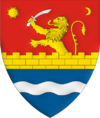- Sânandrei
-
Sânandrei — Commune — Location of Sânandrei in Romania Coordinates: 45°54′38″N 21°09′51″E / 45.91056°N 21.16417°ECoordinates: 45°54′38″N 21°09′51″E / 45.91056°N 21.16417°E Country  Romania
RomaniaCounty Timiş County Status Commune Government - Mayor Population (2002) - Total 1,700 Time zone EET (UTC+2) - Summer (DST) EEST (UTC+3) Sânandrei (German: Sanktandreas, Hungarian: Szentandrás) is a commune in Timiş County, Banat, Romania. It is composed of three villages: Carani, Covaci and Sânandrei.
In 1930, Sânandrei was 79.6% German. By 2002, it was over 92% Romanian.
Contents
Carani
Carani (German: Mercydorf, Hungarian: Merczyfalva, Mercifalva) is one of the commune's villages.
Geography
The village of Carani is located 18 km north of Timişoara, on the DJ692 county road. 3 km to the east lies the National Road DN69, to which Carani is linked by a local road. Additionally, it is accessible by rail, having its own station on the Timişoara - Arad line. 5 km to the north lies the village of Călacea; to the east the village of Corneşti; to the south the centre of Sânandrei commune; and to the west, Hodoni. The Caran River passes through.
History
Carani was built in 1735 by Italian colonists brought by the Habsburg Monarchy as part of a massive effort to populate the Banat with Western Europeans. It was one of the first villages for colonists, founded and inhabited exclusively by Italians, being the only majority-Italian settlement in the entire Banat. The inhabitants grew silkworms, having been brought there in order to start silkworm production in the Banat.
The village was founded under the name of Mercydorf ("Mercy's village"), in honour of General Claudius Florimund Mercy, who was charged with administering the Banat. Later, new waves of colonists arrived – French people and Germans from Alsace-Lorraine. The first came around 1752, then in 1763, so that by 1770, the village was substantially French in character. Religious services were held in three languages: Italian, French and German. However, with time, the village grew more German, in line with the rest of the Banat. By the end of the 18th century, Carani was already a Banat Swabian village.
Tourist attractions
- Count Mercy's castle (1733-1734)
- Roman Catholic church (1734)
Covaci
Covaci (German: Kowatschi; Hungarian: Temeskovácsi) is another of the commune's villages. It was founded in 1843 when German and a few Hungarian settlers were brought to an estate there. Until the latter half of the 20th century, the village had a strong German majority. This changed dramatically due to emigration, so that by 2002, of 751 inhabitants, there were 682 Romanians, 19 Germans, 19 Hungarians and 30 others.
Covaci, which benefits economically from its proximity to Timişoara, is about 10 km north of the city, on the right bank of the Bega Veche River. The village of Cerneteaz is 3 km to the east; to the west is the national road DN69, to which it is linked by a communal road and which goes to Timişoara. Another communal road leads south into the city.
Bibliography
References
External links
- (English) Mercydorf in Banat
- (Romanian) Anuarul Socec al României Mari 1924-1925, Library of Congress
- (Romanian) Photograph of the castle
Categories:- Communes in Timiş County
Wikimedia Foundation. 2010.



